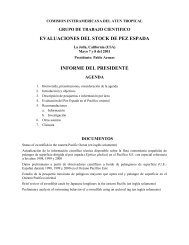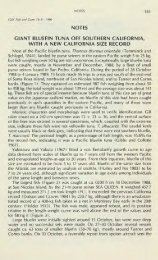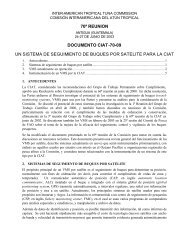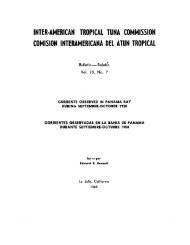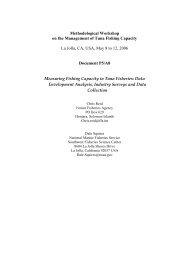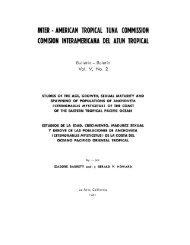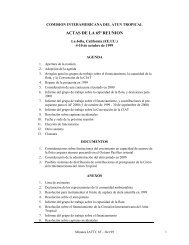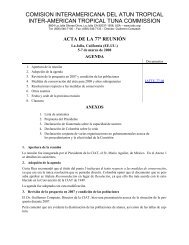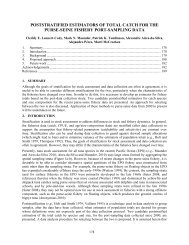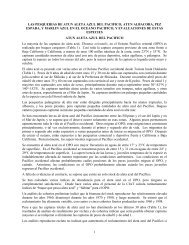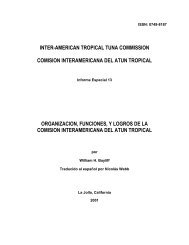INTER-AMERICAN TROPICAL TUNA COMMISSION - Comisión ...
INTER-AMERICAN TROPICAL TUNA COMMISSION - Comisión ...
INTER-AMERICAN TROPICAL TUNA COMMISSION - Comisión ...
- No tags were found...
Create successful ePaper yourself
Turn your PDF publications into a flip-book with our unique Google optimized e-Paper software.
I. STRIPED MARLINStriped marlin occur throughout the Pacific Ocean between about 45°N and 45°S. They are caught mostly by the longline fisheriesof Far East and Western Hemisphere nations. Lesser amounts are caught by recreational, gillnet and other fisheries. During recentyears the greatest catches in the eastern Pacific Ocean (EPO) have been taken by fisheries of Japan, Costa Rica and Korea.Striped marlin reach maturity when they are about 140 cm long, and spawning occurs in widely-scattered areas of the Pacific Ocean.Few tagging data are available on the movements of striped marlin. Tagged fish released off the tip of the Baja California peninsulagenerally have been recaptured in the same general area as where tagged, but some have been recaptured around the RevillagigedoIslands, a few around Hawaii, and one near Norfolk Island. Recently pop-up satellite tags have been placed on striped marlin in thePacific (Domeier 2006), achieving times-at-liberty averaging about 2 to 3 months, with maximums of 4 to 9 months in each taggingregion. These studies indicated that there was essentially no mixing of tagged fish among tagging areas, and that striped marlinmaintained site fidelity.The catch rates of striped marlin off California and Baja California tend to be greater when the sea-surface temperatures are higherand when the thermocline is shallow. The catch rates are greater on the shallower hooks of longlines, especially when thethermocline is shallow.The stock structure of striped marlin is uncertain. Analyses of catch rates using generalized additive models (GAMs) suggest that inthe north Pacific there appear to be at least two stocks, distributed principally east and west of about 145º-150ºW, with thedistribution of the stock in the east extending as far south as 10°-15°S. Genetic studies provide a more detailed picture of stockstructure. McDowell and Graves (2008) suggest that there are separate stocks in the northern, northeastern, and southeastern, andsouthwestern Pacific. Preliminary reports of more recent genetic studies (C. Purcell, University of Southern California, personalcommunication, May 2009) indicate that the striped marlin in the EPO off Mexico, Central America, and Ecuador are of a singlestock and that there may be juveniles from an identified Hawaiian-stock present seasonally in regions of the northern EPO.Analyses of stock status have been made using a number of population dynamics models. The results from these analyses indicatedthat striped marlin in the EPO were at or above the level expected to provide landings at the maximum sustainable yield (MSY),estimated at about 3300 to 3800 t, which is substantially greater than the annual catch in recent years and the new record lowestimated catch of about 1,400 t in 2007. There is no indication of increasing fishing effort or catches in the EPO stock area. Basedon the findings of Hinton and Maunder (2004), new information and recent observations of catch and fishing effort presented herein,it is considered that the striped marlin stocks in the EPO are in good condition, with current and near-term anticipated fishing effortless than F MSY .109



